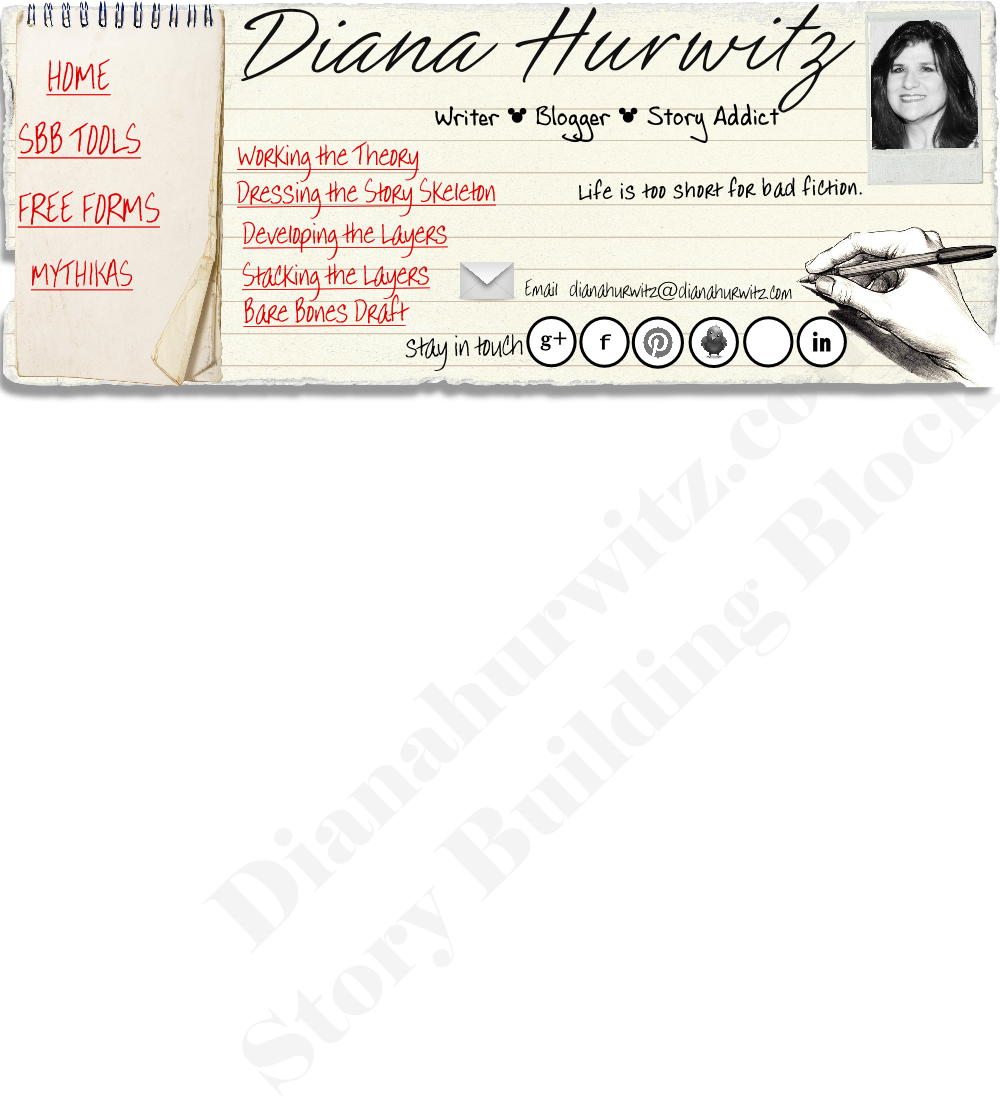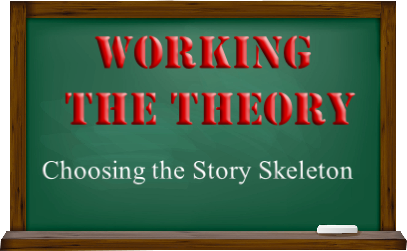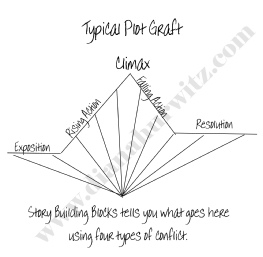


©2018 www.dianahurwitz.com all rights reserved •Designed by Diana Hurwitz

Let’s say you have an idea for a story involving a meteor streaking toward earth, a conflicted scientist, his crumbling marriage, and coworkers who make his life miserable. How do you decide what to do with it? There are hundreds of variations on the same premise. You develop the idea by choosing a story skeleton and dressing it up to suit your taste. Let’s start with choosing a story skeleton based on the central question. Every plot hinges on a central question. Posing the question at the beginning of the tale and answering it at the end is sound story architecture.
The Romance skeleton poses the central question: Will they or won’t they end up together? The answer had better be “yes” or a satisfying equivalent. The girl can find out guy A isn’t what she wanted after all because she found guy B, but this is not the genre for an “I’m okay on my own” ending. That story uses the Literary or Women's Fiction skeleton. Romance readers want passion and fulfillment and are very disappointed if they don’t get it.
The Mystery skeleton poses the central question: Who did it and will they catch him? The suspect is identified and the crime is solved. The criminal may escape at the last moment to torment the detective another day, but the case that is the focus of the story is considered solved. Twists where someone other than the detective solves the crime or there wasn’t a crime after all should be rerouted to the Thriller section.
The Thriller skeleton poses the central question: How will they, and by proxy we, survive the threat to an individual or society? For an "up" ending, the hero succeeds. If you want a "down" ending, the hero can fail and learn an ugly truth. Twists often provide an unexpected answer in this genre.
The Con, Heist & Prison Break skeleton poses the central question: What is really going on and will the plan succeed?
The plan may be straightforward and the goal obvious or there can be lots of twists and turns. The protagonist can succeed or fail. The reader can hope for the protagonist to succeed or fail. There is often a team. Some of them are sacrificed along the way.
The Gothic skeleton poses the central question: When will she realize the danger and how will she escape? This is typically a well-intentioned protagonist who stumbles upon a festering secret. Her arrival acts as a catalyst that brings it to the surface. The reader is anxious for her to realize her mistake and flee, or expunge the necrosis and live happily ever after in the newer, healthier world. A new status quo is preferred, but she can escape the scene when she realizes the world she has stumbled upon is too diseased to be cured.
The Horror skeleton poses the central question: What brought the danger near and how will they escape it? The answer can go either way as long as you reveal the reason why. Some horror stories ignore the first half of the question, but fans consider that a weak story. Fans usually want the main character to live to be frightened another day, even if every other character is knocked off by the tale's end.
The Science Fiction skeleton poses the central question: Will the hero find, change, or stop something in time? Most fans prefer an "up" ending. They want to believe that we can overcome the challenges to our existence, especially if you plan a sequel.
The Fantasy skeleton poses the central question: Will the hero obtain or learn to use the power to defeat the evil that has disrupted his world in time? The force is usually with the hero. The wicked witch gets her just due. Lord Voldemort is defeated. If you plan a sequel, the villain can live to fight the hero another day, but the story must show a resolution to a skirmish in the battle.
The Western skeleton poses the central question: How will they overcome the difficulty and will they stay or leave?
Leaving, staying, or accepting a new status quo are all acceptable answers. The protagonist’s quest can drastically change him or he can remain steadfast. The ending can be up or down or up-down. The protagonist generally lives, but often makes sacrifices along the way.
The Historical skeleton poses the central question: What happened and how did it change things? he overall story problem focuses on the historical situation with emphasis on a point in history. It can shed new light, debunk old theories, or twist history in an unusual way. The protagonist can succeed or fail, live or die.
The Team Victory skeleton poses the central question: Will they win? They should. If they don’t, they have to still feel really good about it: almost was good enough. There can be a series of successes and failures along the way.
The Road Trip skeleton poses the central question: How did this journey change him? In the road trip scenario, it is rarely the destination that is important. He can succeed or fail in reaching it. The reader cares about the protagonist’s journey and the lessons he learns along the way.
The Comedy skeleton poses the central question: What do I think and how has this changed it? A good comedy exposes human foibles, prejudices, and practices. It can utilize exaggeration or subtlety to achieve its stealth purpose … as long as it leaves them laughing.
The Literary/Drama skeleton poses the central question: What are they feeling and how will it change? The conflict in a literary story typically revolves around a wrenching personal crisis or decision. It can be slow-moving and highly thought-provoking. It can be emotionally fraught or as subtle as a spring breeze. The ending can be uplifting, upsetting, or left unresolved.
Let’s play with skeleton selection with a few broad options. We start with a story idea about protagonist Dick, love interest Sally, bossy Jane, jealous Ted, and a meteor streaking toward earth.
OPTION ONE: We can dress up the Literary skeleton and explore the theme that relationships are vulnerable to unexpected blows. The impending meteor strike could be real or imagined, past or present. The tension it creates, or the mystery that surrounds it, tests the bonds of the people involved. Threatening situations can bring out the best or worst in people. The central question becomes: What life altering decision will Dick make and how will it affect his life? He can decide to walk away from his chosen career, stay or leave an unsatisfying relationship, or come to terms with the fact that you can’t save everyone, especially from themselves.
OPTION TWO: We can take it on a Road Trip. Dick, Sally, Jane, and Ted travel to the crash site. What they find when they get there isn’t the main concern, it is what they learn along the way. The central question is: What is he feeling and how does it change? Dick can gain an important insight about himself, clear up a misunderstanding from the past. He can find out Sally is having an affair with Ted and Jane has always been in love with him. External obstacles make the destination difficult to reach and interpersonal squabbles bring the conflict to a head, but the internal journey is the focus. The Road Trip could be a slow psychological dissection or a hilarious Comedy.
OPTION THREE: We can wrangle it into a Western. Dick is the Sheriff. Ted owns the ranch where the meteor landed. Jane is the saloon girl who secretly pines for Dick while fighting off unwelcome advances from Ted. Sally is the new widow in town that Dick falls for. The Indians see the meteor as a sign that the white man must leave town or their world will be destroyed. The overall story question becomes: Will they overcome the challenges and stay or will they go?
OPTION FOUR: We can warp it into a Science Fiction future where the meteor is being
controlled by savage Carpathians. Dick is the ship’s captain. Ted is his argumentative
first officer. Jane is his communications director and is having an affair with Ted.
Jane wants Ted to take the Captain’s seat so she can become first officer. Sally
is the security chief and half Carpathian. Dick is intent on finding a way to turn
the meteor against the Carpathians while Sally lobbies for a peaceful resolution.
After all, not all Carpathians are evil. Ted and Jane realize at the last minute
that if Dick fails, they all die along with promotional possibilities. Sally forges
a peace treaty while Ted and Jane live to plot another day and Dick is once again
the hero in the eyes of the federation.
Which category do you want to explore with your premise? You may not be certain yet. There are subcategories to consider. You can mix genres. You can bend and twist genres. But at some point, you have to pick a main through line that gives a story direction and momentum. You can have a historical thriller with romantic complications. If it is heavy on romance with the thriller threat as a complication, you market it as romance. If you follow the thriller skeleton, the romance complicates the threat they overcome at the end. The way you layer the genres affects the skeleton dressing, but the central question drives the marketing. Next, let’s consider how subgenres affect the choices.
